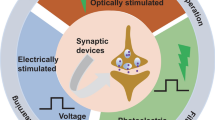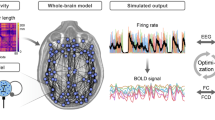Abstract
Neurons communicate primarily through synapses. A neuron is usually affected by multiple synapses, which could be chemical/electrical or excitatory/inhibitory ones at the same time. Here, we make the realistic assumption that a excitatory and inhibitory balanced modular small-world network is established and focuses on the effects of hybrid chemical and electrical synapses, noise and time delay on coherence resonance of the constructed network. It is found that when the ratio f of chemical synapses to electrical synapses approaches odd ratios, coherence resonance is better than those f close to even ratios for appropriate noise intensities. Furthermore, with f increasing, it is observed that effects of chemical and electrical synapses on coherence resonance are nearly opposite. It indicates that electrical synapses are more efficient than chemical ones. Meanwhile, multiple coherence resonances are observed when time delay is introduced into the network, and it is independent of f. Finally, we demonstrate that coherence resonance decreases as the number of subnetworks increases, and when the number of subnetworks is larger, the resonance behaviour weakens or vanishes with increasing f.












Similar content being viewed by others
Data availability statement
Data sharing not applicable to this article as no data sets were generated or analyzed during the current study.
References
S.G. Lee, S. Kim, Parameter dependence of stochastic resonance in the stochastic Hodgkin-Huxley neuron. Phys. Rev. E 60, 826 (1999)
Q.Y. Wang, X. Wang, Synchronization Dynamics of Neurons Coupled Systems (Science Press, Beijing, 2007)
R. Benzi, A. Sutera, A. Vulpiani, The mechanism of stochastic resonance. J. Phys. A: Math. Gen. 14, L453 (1981)
L.Gammaitoni, P.Hanggi, P.Jung, et al., Stochastic resonance. Rev. Mod. Phys. 70, 223 (1998)
A.S. Pikovsky, J. Kurths, Coherence resonance in a noise-driven excitable system. Phys. Rev. Lett. 78, 775 (1997)
S.G. Lee, A. Neiman, S. Kim, Coherence resonance in a Hodgkin-Huxley neuron. Phys. Rev. E 57, 3292 (1998)
T. Mori, S. Kai, Noise-induced entrainment and stochastic resonance in human brain waves. Phys. Rev. Lett. 88, 218101 (2002)
Y. Gong, M. Wang, Z. Hou, H. Xin, Optimal spike coherence and synchronization on complex Hodgkin-Huxley neuron networks. ChemPhysChem. 6, 1042–1047 (2005)
G. Deco, M.L. Kringelbach, Metastability and coherence: extending the communication through coherence hypothesis using a whole-brain computational perspective. Trends Neurosci. 39, 125 (2016)
A.N.Pisarchik, V.A.Maksimenko, A.V.Andreev, et al., Coherent resonance in the distributed cortical network during sensory information processing. Sci. Rep. 9, 18325 (2019)
T.Aihara, K.Kitajo, et al., Internal noise determines external stochastic resonance in visual perception. Vision. Res. 48, 1569 (2008)
M. Perc, Spatial coherence resonance in excitable media. Phys. Rev. E 72, 016207 (2005)
T. Kreuz, S. Luccioli, A. Torcini, Double coherence resonance in neuron models driven by discrete correlated noise. Phys. Rev. Lett. 97, 238101 (2006)
Q. Wang, H. Zhang, M. Perc, G. Chen, Multiple firing coherence resonances in excitatory and inhibitory coupled neurons. Commun. Nonlinear Sci. 17, 3979–3988 (2012)
Y. Jia, H. Gu, Transition from double coherence resonances to single coherence resonance in a neuronal network with phase noise. Chaos 25, 123124 (2015)
Y. Zheng, Y. Yang, Bounded noise-induced coherence resonance in a single Rulkov neuron. Indian J. Phys. 93, 1477–1484 (2019)
L. Li, Z. Zhao, White-noise-induced double coherence resonances in reduced Hodgkin-Huxley neuron model near subcritical Hopf bifurcation. Phys. Rev. E 105, 034408 (2022)
M. Masoliver, N. Malik, E. Scholl, A. Zakharova, Coherence resonance in a network of FitzHugh-Nagumo systems: interplay of noise, time-delay, and topology. Chaos 27, 101102 (2017)
D. Ristic, M. Gosak, Interlayer connectivity affects the coherence resonance and population activity patterns in two-layered networks of excitatory and inhibitory neurons. Front. Comput. Neurosci. 16, 885720 (2022)
X. Sun, Q. Lu, J. Kurths, Correlated noise induced spatiotemporal coherence resonance in a square lattice network. Phys. A 387, 6679 (2008)
C.C. Hilgetag, M. Kaiser, Clustered organization of cortical connectivity. Neuroinformatics 2, 353–360 (2004)
N.Mishra, R. Karan, B.Biswal, et al., A model for the evolution of the neuronal network in kindled brain slices. Phys. A 505, 444-453 (2018)
D.Meunier, R.Lambiotte, E.T.Bullmore, Modular and Hierarchically Modular Organization of Brain Networks. Front. Neurosci. 4 (2010)
O. Sporns, Network attributes for segregation and integration in the human brain. Curr. Opin. Neurobiol. 23, 162–171 (2012)
X.Jia, J.H.Siegle, S.Durand, G.Heller, Ramirez, et al., Multi-regional module-based signal transmission in mouse visual cortex. Neuron 110, 1585-1598 (2022)
H. Han, S. Ge, H. Wang, Prediction of brain age based on the community structure of functional networks. Biomed. Signal Process. Control 79, 104151 (2023)
P.C. Antonello, T.F. Varley, J. Beggs et al., Self-organization of in vitro neuronal assemblies drives to complex network topology. Elife 11, e74921 (2021)
J.W. Scannell, C. Blakemore, M.P. Young, Analysis of connectivity in the cat cerebral cortex. J. Neurosci. 15, 1463–1483 (1995)
X. Sun, J. Lei, M. Perc, J. Kurths, G. Chen, Burst synchronization transitions in a neuronal network of subnetworks. Chaos 21, 016110 (2011)
H.Yu, J.Wang, C.Liu, et al., Stochastic resonance on a modular neuronal network of small-world subnetworks with a subthreshold pacemaker. Chaos 21, 047502 (2011)
z.Liu, X.Sun, H.Li, Stochastic multi-resonance induced by noise in a neuronal network of subnetworks. Journal of Dynamics and Control 17, 191-196 (2019)
T.C. Sudhof, R.C. Malenka, Understanding synapses: past, present, and future. Neuron 60, 469–476 (2008)
B.W. Connors, M.A. Long, Electrical synapses in the mammalian brain. Annu. Rev. Neurosci. 27, 393–418 (2004)
P. Balenzuela, J. Garca-Ojalvo, Role of chemical synapses in coupled neurons with noise. Phys. Rev. E 72, 021901 (2005)
X. Shi, Q. Wang, Q. Lu, Firing synchronization and temporal order in noisy neuronal networks. Cogn. neurodynamics 2, 195 (2008)
C.I. Zeeuw, C.C. Hoogenraad, S.K.E. Koekkoek et al., Microcircuitry and function of the inferior olive. Trends Neurosci. 21, 391–400 (1998)
D. Friedman, B.W. Strowbridge, Both electrical and chemical synapses mediate fast network oscillations in the olfactory bulb. J. Neurophysiol. 89, 2601–2610 (2003)
F.Hamzei-Sichani, K.G.Davidson, T.Yasumura, et al., Mixed electrical-chemical synapses in adult rat hippocampus are primarily glutamatergic and coupled by connexin-36. Front. Neuroanat. 6, 13 (2012)
N. Kopell, B. Ermentrout, Chemical and electrical synapses perform complementary roles in the synchronization of interneuronal networks. P. Natl. A. Sci. 101, 15482–15487 (2004)
H. Yu, X. Guo, J. Wang, Stochastic resonance enhancement of small-world neural networks by hybrid synapses and time delay. Commun. Nonlinear. Sci. 42, 532–544 (2017)
G.G. Turrigiano, S.B. Nelson, Homeostatic plasticity in the developing nervous system. Nat. Rev. Neurosci. 5, 97–107 (2004)
Y. Wang, S. Sugita, T.C. Sudhof, J. Biol, The RIM/NIM family of neuronal C2 domain proteins: interactions with Rab3 and a new class of Src homology 3 domain proteins. J. Biol. Chem. 275, 20033–20044 (2000)
G.G. Turrigiano, S.B. Nelson, Hebb and homeostasis in neuronal plasticity. Curr. Opin. Neurobiol. 10, 358–364 (2000)
C.Liu, J.Wang, Yu, H., B.Deng, et al., The effects of time delay on the synchronization transitions in a modular neuronal network with hybrid synapses. Chaos Solitons Fractals 47, 54-65 (2013)
H. Li, X. Sun, J. Xiao, Degree of synchronization modulated by inhibitory neurons in clustered excitatory-inhibitory recurrent networks. Europhys. Lett. 121, 10003 (2018)
B. Ibarz, J.M. Casado, M.A. Sanjuan, Map-based models in neuronal dynamics. Phys. Rep. 501, 1–74 (2011)
M. Gosak, R. Markovi, M. Marhl, The role of neural architecture and the speed of signal propagation in the process of synchronization of bursting neurons. Phys. A 391, 2764–2770 (2012)
H. Wu, Z. Hou, H. Xin, Delay-enhanced spatiotemporal order in coupled neuronal systems. Chaos 20, 043140 (2010)
X.L. Yang, D.V. Senthilkumar, J. Kurths, Impact of connection delays on noise-induced spatiotemporal patterns in neuronal networks. Chaos 22, 043150 (2012)
X.Sun, J.Lei, M.Perc, et al., Burst synchronization transitions in a neuronal network of subnetworks. Chaos 21, 016110 (2011)
Q. Wang, G. Chen, Delay-induced intermittent transition of synchronization in neuronal networks with hybrid synapes. Chaos 21, 013123 (2011)
H. Gu, Z. Zhao, Dynamics of time delay-induced multiple synchronous behaiors in inhibitory coupled neurons. PLoS One 10, e0138593 (2015)
A.S. Pikovsky, J. Kurths, Coherence resonance in a noise-driven excitable system. Phys. Rev. Lett. 78, 775 (1997)
Q. Wang, M. Perc, Z. Duan, G. Chen, Delay-enhanced coherence of spiral waves in noisy Hodgkin-Huxley neuronal networks. Phys. Lett. A 372, 5681–5687 (2008)
H. Yu, X. Guo, J. Wang et al., Adaptive stochastic resonance in self-organized small-world neuronal networks with time delay. Commun. Nonlinear Sci. 29, 346–358 (2015)
Y. Hao, Y. Gong, X. Lin, Multiple resonances with time delays and enhancement by non-Gaussian noise in Newman-Watts networks of HodgkinCHuxley neurons. Neurocomputing 74, 1748–1753 (2011)
Y. Jiang, Multiple dynamical resonances in a discrete neuronal model. Phys. Rev. E 71, 057103 (2005)
X. Sun, G. Li, Synchronization transitions induced by partial time delay in a excitatory-inhibitory coupled neuronal network. Nonlinear Dyn. 89, 2509–2520 (2017)
G. Li, X. Sun, Effects of hybrid synapses and partial time delay on stochastic resonance in a small-world neuronal network. Acta. Phys. Sinch. Ed. 66, 220502 (2017)
D.J. Watts, S.H. Strogatz, Collective dynamics of ‘small-world’ networks. Nature 393, 440–442 (1998)
E.R.Kandel, J.H.Schwartz, T.M.Jessell, et al., Principles of neural science. McGraw-Hill, New York (2000)
S.G.Hormuzdi, M.A.Filippov, G.Mitropoulou, et al., Electrical synapses: a dynamic signaling system that shapes the activity of neuronal networks. BBA-Biomembranes, 1662, 113-137 (2004)
H.Yu, J.Wang, C.Liu, et al., Delay-induced synchronization transitions in modular scale-free neuronal networks with hybrid electrical and chemical synapses. Phys. A 405, 25-34 (2014)
N.F. Rulkov, Regularization of synchronized chaotic bursts. Phys. Rev. Lett. 86, 183 (2001)
N.F. Rulkov, I. Timofeev, M. Bazhenov, Oscillations in larg-scale cortical networks: map-based model. J. Comput. Neurosci. 17, 203–223 (2004)
Q. Wang, M. Perc, Z. Duan, G. Chen, Delay-induced multiple stochastic resonances on scale-free neuronal networks. Chaos 19, 023112 (2009)
X.J. Sun, G.F. Li, Stochastic multi-resonance induced by partial time delay in a Watts-Strogatz small-world neuronal network. Acta. Phys. Sinch. Ed. 65, 090501 (2016)
H. Yu, J. Wang, J. Sun, H. Yu, Effects of hybrid synapses on the vibrational resonance in small-world neuronal networks. Chaos 22, 033105 (2012)
E. Yilmaz, M. Uzuntarla, M. Ozer, M. Perc, Stochastic resonance in hybrid scale-free neuronal networks. Phys. A 392, 5735 (2013)
J.S. Kim, M. Kaiser, From Caenorhabditis elegans to the human connectome: a specific modular organization increases metabolic, functional and developmental efficiency. Phil. Trans. R. Soc. Lond. B 369, 1–9 (2014)
Acknowledgements
This work was supported by the Research Program of Science and Technology at Universities of Inner Mongolia Autonomous Region funded by the Education Department of Inner Mongolia Autonomous Region (No. NJZY22353), and by the scientific researching fund of Pioneer College of Inner Mongolia University.
Author information
Authors and Affiliations
Corresponding author
Ethics declarations
Conflict of Interest
The authors declare that they have no conflict of interest.
Rights and permissions
Springer Nature or its licensor (e.g. a society or other partner) holds exclusive rights to this article under a publishing agreement with the author(s) or other rightsholder(s); author self-archiving of the accepted manuscript version of this article is solely governed by the terms of such publishing agreement and applicable law.
About this article
Cite this article
Li, G., Sun, X. Coherence resonance modulated by hybrid synapses and time delay in modular small-world neuronal networks with E–I balanced state. Eur. Phys. J. Spec. Top. (2023). https://doi.org/10.1140/epjs/s11734-023-00992-5
Received:
Accepted:
Published:
DOI: https://doi.org/10.1140/epjs/s11734-023-00992-5




